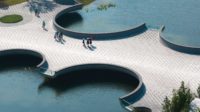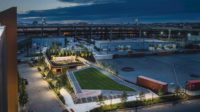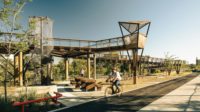Although it does have a celebrated park built directly over a major freeway, Dallas cannot claim bragging rights as the first city to create one. (Per the Federal Highway Administration, Seattle maintains that distinction with its aptly named Freeway Park, which opened in 1976.) Since debuting in 2012, the OJB Landscape Architecture–designed Klyde Warren Park, which spans a below-grade section of the Woodall Rogers Freeway to unite the downtown Dallas Arts District with the fast-growing Uptown district, has served as an exemplar of infrastructure-topping parks that (re)connect freeway-sundered neighborhoods while generating new open public space for recreational and cultural pursuits.
Beginning in 2025, Texas’s interstate-tangled third-largest city will be able to boost two freeway-lid parks with the planned first-phase completion of Southern Gateway Park. Designed by the Dallas offices of HKS and SWA with Pacheco Koch, the new park will cover a section of I-35E between Ewing and Lancaster avenues adjacent to the Dallas Zoo. Capping 5.5 acres of freeway and extending to Marsalis Avenue when fully completed, Southern Gateway Park will stitch together long-severed sections of Oak Cliff, a sprawling patchwork of communities colloquially referred to simply as South Dallas and originally developed as a separate township, before its annexation in 1903. Like far too many interstate construction projects initiated during the mid-20th century, I-35 bisected a historic Black community in the southeast of Oak Cliff, taking with it property and prosperity.

Deck construction over 1-35E in Oak Cliff was completed by the Texas DOT last year. Photo © David Lloyd / SWA, click to enlarge.
“In following years, lack of capital investment and adequate services contributed to generational poverty, social isolation, environmental injustice, and economic despair for much of southern Dallas,” summarizes SWA in a statement, adding that this “park with a purpose” is an opportunity to “knit historic Oak Cliff back together and to create a physical connection and public space that drives equitable community revitalization and economic mobility.”
As notes April Allen, a longtime Oak Cliff resident who serves as president and CEO of the nonprofit Southern Gateway Public Green Foundation, this is what sets Dallas’s next freeway-deck park apart from its celebrated predecessor. “Klyde Warren Park has been a runaway success, but what’s different about our project is the community that we’re in,” she says. “We’re really about reconnecting a neighborhood that was divided by the interstate system.”
Work on the $82 million first phase of Southern Gateway Park kicked off last November, following the completion of the deck structure by the Texas Department of Transportation as part of a multiphase reconstruction/widening project along I-35E. Like Klyde Warren Park, it is being executed through a public-private partnership.
With construction on the initial 2.8-acre section of the park under way, Allen hopes it will be aspirational for similar projects in more preliminary stages seeking funding from the U.S. Department of Transportation’s first-of-its-kind Reconnecting Communities and Neighborhoods Grant Program. “We feel like we’re kind of the poster child for the program,” says Allen. “There are a lot of other communities looking at grant funding for planning purposes at this stage, but, in terms of actual construction, we are, to my knowledge, the furthest along for a project located in a historically under-resourced neighborhood impacted by the freeway system.” (Late last year, the North Central Texas Council of Governments applied for a total of $95 million in grant funding through the program for the second phase of Southern Gateway Park, along with three other freeway-lid park projects.)
What can be expected when the first phase of Southern Gateway Park opens next year? The design, guided by an equitable development plan with vital input from the community, references the unique topography of Oak Cliff through undulating-pathway-laced landforms dotted with mature trees. Locals will recognize that the design echoes the area’s signature geographic feature, a craggy limestone escarpment. The park “visually matches the neighborhood, its vegetation and topography,” says Chuck McDaniel, lead designer and founding principal of SWA’s Dallas studio.
Within this rolling interstate-blanketing landscape, the design team packs in myriad amenities: a terrace-topped restaurant and retail building tucked beneath a manmade hill, water features, a wide public promenade cutting diagonally through the park, and flexible gathering and performance spaces, including a sprawling open lawn and a stage pavilion. On the south side of the park will be the first part of a destination playground, which will double in size with the completion of phase two. Play equipment is being built from natural materials, going for what McDaniel calls “a playhouse-in-the-woods notion, as if the children themselves cobbled it together in the ravine.”
There are also plans for features throughout the park that relay the history and culture of Oak Cliff, including what Allen calls an “Oak Cliff Walk of Fame” on the main promenade, where the names of notable community members would be engraved in bronze pavers, complete with QR codes that will lead to biographical information about them online. There’s also the potential for a public art program, although details of that have yet to be ironed out.
Along with Southern Gateway Park’s primary role as a community-unifying green space in a pocket of Dallas starved of walking-distance public parks, there are hopes that, like Klyde Warren Park, it will serve as a catalyst for economic growth.
“The community felt that a deck park was very equitable—it’s new ground that everybody can celebrate,” says McDaniel. “And it was really refreshing on our end to think that this could become something that local residents would rally around.”
Click plan to enlarge







Post a comment to this article
Report Abusive Comment